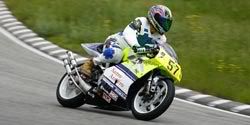I'm new to 2 stroke bikes but recently became hooked after trying an NSR 250 for the first time. Now I'm obsessed about owning one and losing sleep thinking about them (must be love
Anyways, my question has to do with 2 stroke exhaust systems. I understand that 2 strokes use expansion chambers that are specially designed to use the resonance of exhaust waves to increase performance. I was looking at the different styles of pipes and noticed something on the GP style pipes (where both silencers are on the right side) that I don't understand. In the pictures the convergent, belly and divergent sections (the bulge part) are the same size on both cylinders. The skinny stinger section before the silencers however is significantly longer on the left side pipe. My question is, does the big difference in length between the two pipes cause any kind of change in performance or characteristics between the two cylinders. Do you need to compensate for the difference somehow like different jetting for each cylinder?
Here is a picture from Tyga Performance: link
Thanks in advance for your help!






